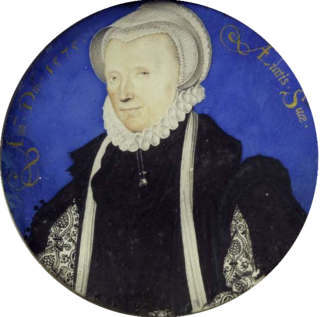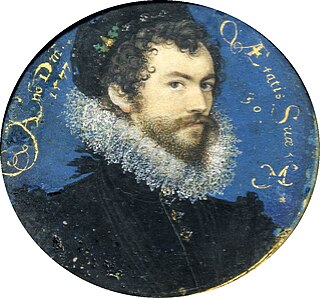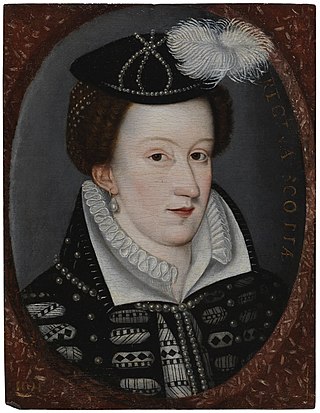Affabel Partridge was a London goldsmith who served Elizabeth I. He is thought to have marked his work with a hallmark of a bird. [1]
Contents


Affabel Partridge was a London goldsmith who served Elizabeth I. He is thought to have marked his work with a hallmark of a bird. [1]


Partridge was an apprentice of Richard Crompton. He worked at the sign of the Black Bull in Cheapside. [2] On 25 July 1554 (her wedding day), Mary I of England ordered some of the jewels in the Tower of London to be delivered to her goldsmith "Affabel Partriche". [3]
With Robert Brandon, he became a goldsmith to Elizabeth I on her accession. [4] They were joined by Hugh Keall in 1577. [5]
Brandon and Partridge supplied hundreds of pieces of plate which Elizabeth distributed as New Year's Day gifts, and as gifts on other occasions. They also repaired tableware. [6] In September 1560 Partridge and Brandon received 4000 ounces of silver plate scrapped from the Jewel House as unfit to serve at the queen's table, to be melted down and made into new objects. [7]
Partridge established himself on Cheapside at the "Sign of the Black Bull". [8] On 25 July 1560, Partridge was employed to repair and reset old jewels from the Tower of London into a "better fashion" for Queen Elizabeth to wear from time to time, meet and suitable for her occasional use. The pieces for refashioning were "fifty tablets of sundry fashion tied upon a string whereof diverse have pomanders within them", and broken nether and upper habiliments (the jewelled bands which were worn at the forehead of a French hood), with aglets and their laces and pins. Partridge was to pay attention to the enamelling. The aged Marquess of Winchester was ordered to deliver the jewels to the goldsmith. [9]
Partridge and Brandon were permitted to collect base money for refining at the royal mint in October 1560. [10]
Partridge sued Edward Baeshe of West Coker for the value of a garter set with rubies and pearls in 1565. Baeshe had paid for a gold flower set with diamonds and pearls. [11]
"Aphabelle Partridge" subscribed to a general lottery in 1568, and wrote this verse:
In 1576 Partridge supplied three gilt salts with "a cover of the French making". [13] "Affabell Partrydge" signed the vestry minutes of Stepney parish twice in 1583 and probably died in that year. [14]
Partridge lent money to a goldbeater Robert Mabbe, a son of the goldsmith John Mabbe, taking as security a share of the Tabard Inn, Southwark. [15]
Partridge and Brandon were succeeded as royal goldsmiths by Richard Martin and Hugh Kayle. [16]
He is said to have married (1) Anne Fildus, (2) Margery Gilbard. [17] His third wife was Denise or Dionise, the widow of John Owtred who held land in Havering. [18] His children included:

Margaret Douglas, Countess of Lennox, was the daughter of the Scottish queen dowager Margaret Tudor and her second husband Archibald Douglas, 6th Earl of Angus, and thus the granddaughter of King Henry VII of England and the half-sister of King James V. She was the grandmother of King James VI and I.

Lady Mary Keyes was the youngest daughter of Henry Grey, 1st Duke of Suffolk, and Frances Brandon, and through her mother had a claim on the crown of England.

Nicholas Hilliard was an English goldsmith and limner best known for his portrait miniatures of members of the courts of Elizabeth I and James I of England. He mostly painted small oval miniatures, but also some larger cabinet miniatures, up to about 10 inches tall, and at least two famous half-length panel portraits of Elizabeth. He enjoyed continuing success as an artist, and continuing financial troubles, for forty-five years. His paintings still exemplify the visual image of Elizabethan England, very different from that of most of Europe in the late sixteenth century. Technically he was very conservative by European standards, but his paintings are superbly executed and have a freshness and charm that has ensured his continuing reputation as "the central artistic figure of the Elizabethan age, the only English painter whose work reflects, in its delicate microcosm, the world of Shakespeare's earlier plays."
Robert Richardson was a Scottish Prior of St Mary's Isle and royal administrator.
Robert Brandon was an English goldsmith and jeweller to Queen Elizabeth I of England. A prominent member of the Goldsmiths' Company, Brandon was elected Chamberlain or treasurer of the City of London in 1583, a position he held until his death in 1591.
Richard Masters was a leading 16th-century English physician and personal doctor of Queen Elizabeth.
Edward Baeshe or Bashe was an English naval administrator and politician.
Sir William Herrick or Hericke was an English jeweller, courtier, diplomat and politician who sat in the House of Commons at various times between 1601 and 1622.
Sir Thomas Ramsey (1510/11–1590) was a merchant, and an Alderman of London from 1566 to 1590. He was knighted, served as Sheriff in 1567–68 and Lord Mayor in 1577–78. His second wife Mary Ramsey was a noted philanthropist.
Costume and gold and silver plate belonging to Elizabeth I were recorded in several inventories, and other documents including rolls of New Year's Day gifts. Arthur Jefferies Collins published the Jewels and Plate of Queen Elizabeth I: The Inventory of 1574 from manuscripts in 1955. The published inventory describes jewels and silver-plate belonging to Elizabeth with detailed references to other source material. Two inventories of Elizabeth's costume and some of her jewellery were published by Janet Arnold in Queen Elizabeth's Wardrobe Unlocke'd.

Nazareth or Nazaret Newton was a courtier and lady-in-waiting.

The jewels of Mary, Queen of Scots (1542–1587), are mainly known through the evidence of inventories held by the National Records of Scotland. She was bought jewels during her childhood in France, adding to those she inherited. She gave gifts of jewels to her friends and to reward diplomats. When she abdicated and went to England many of the jewels she left behind in Scotland were sold or pledged for loans, first by her enemies and later by her allies. Mary continued to buy new jewels, some from France, and use them to reward her supporters. In Scotland her remaining jewels were worn by her son James VI and his favourites.
Henry Middlemore was an English courtier and diplomat.
Hugh Kayle or Keale or Keall was a London goldsmith who served Elizabeth I from 1577.

An inventory of the jewels of Mary I of England, known as Princess Mary or the Lady Mary in the years 1542 to 1546, was kept by her lady in waiting Mary Finch. The manuscript is now held by the British Library. It was published by Frederic Madden in 1831. Some pieces are listed twice. The British Library also has an inventory of the jewels she inherited on coming to the throne in 1553.
John Mabbe or Mab was the name of two English goldsmiths working in Tudor London.
Hans of Antwerp was a goldsmith and merchant working in Tudor London. He supplied silver plate and jewels to the court of Henry VIII.
William Ward was an English goldsmith and financier from London, involved in the manufacture of glass.

Edward Cary or Carey or Carye was an English courtier and Master of the Jewel Office for Elizabeth I and James VI and I.
At the Tudor and Stuart royal courts in Britain it was traditional to give gifts on New Year's Day, on 1 January. Records of these gift exchanges survive, and provide information about courtiers and their relative status.